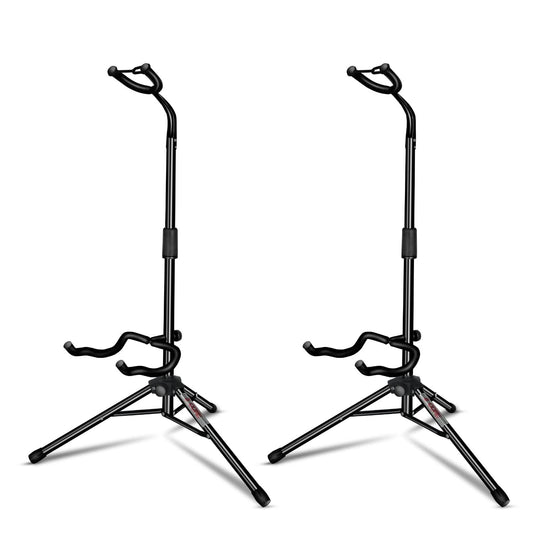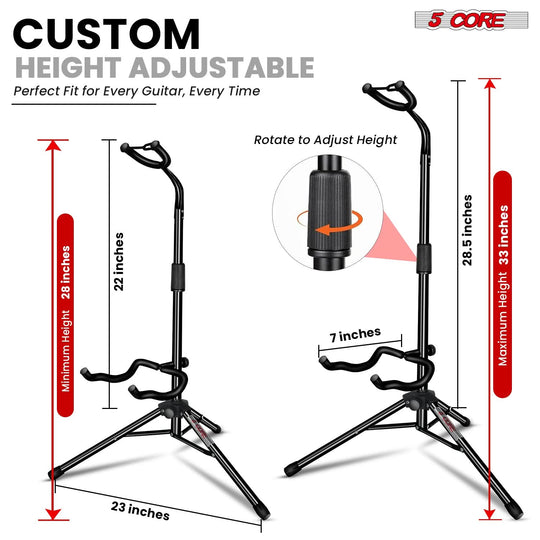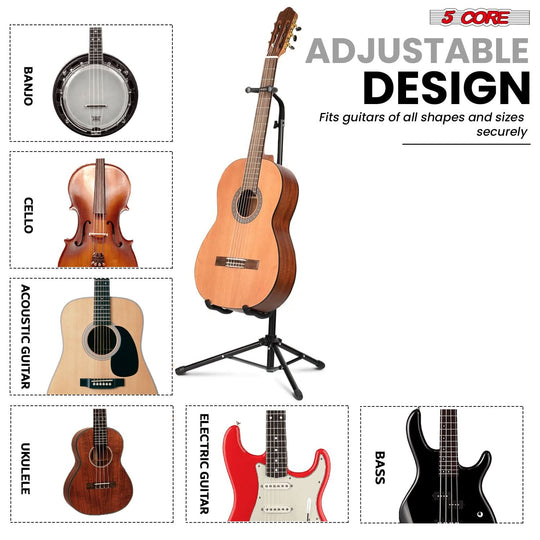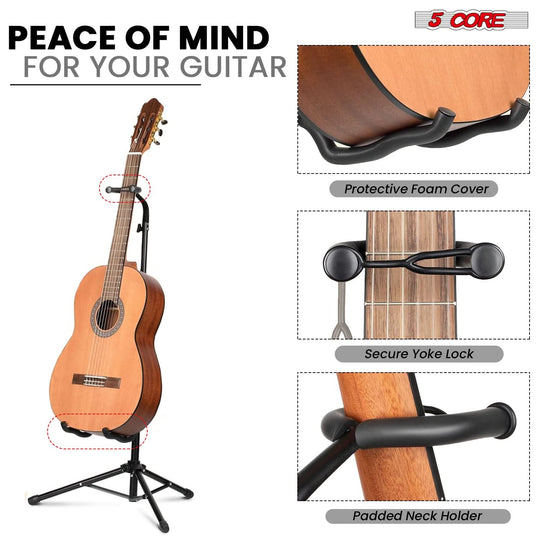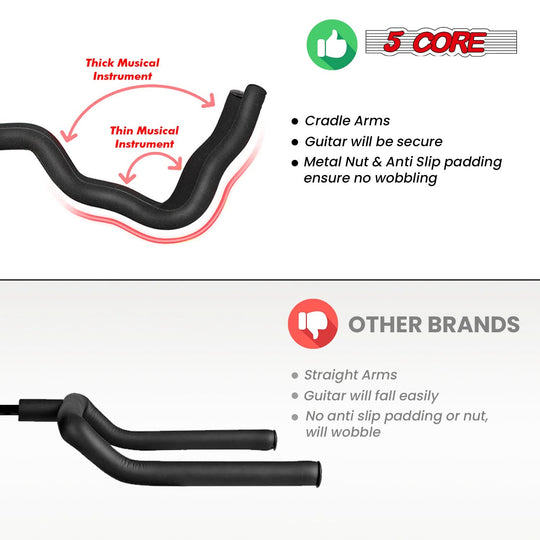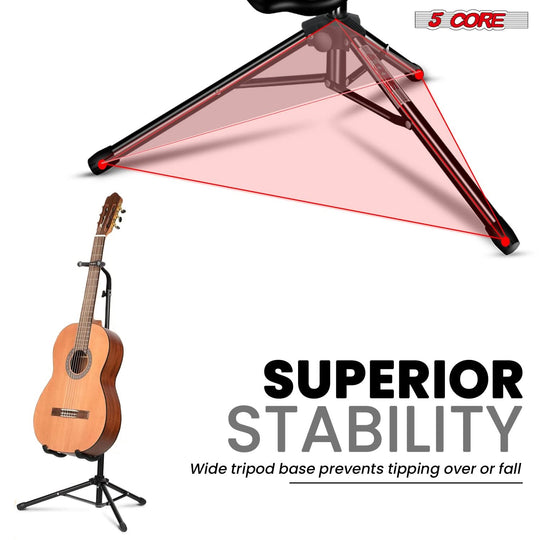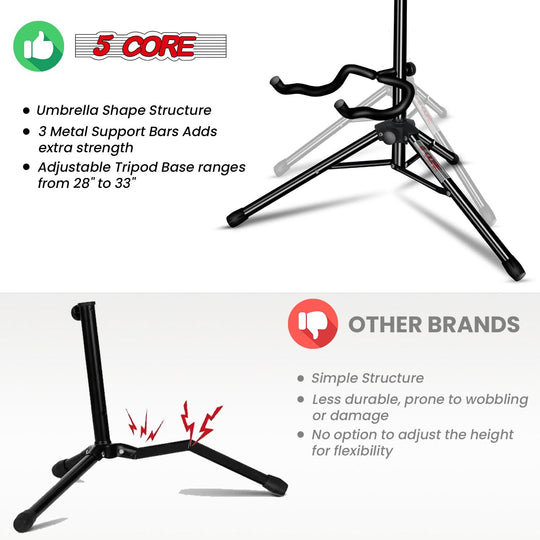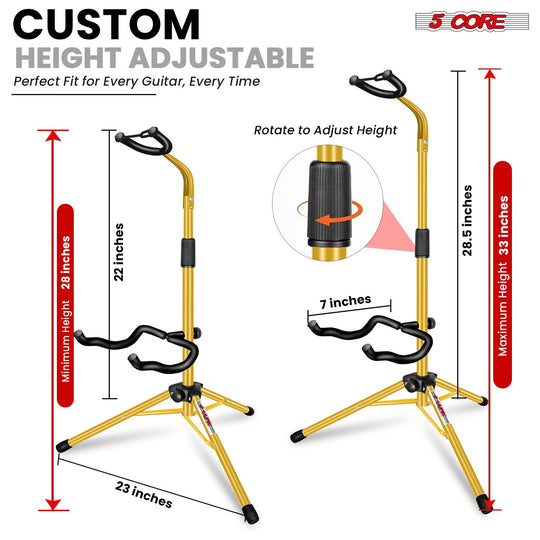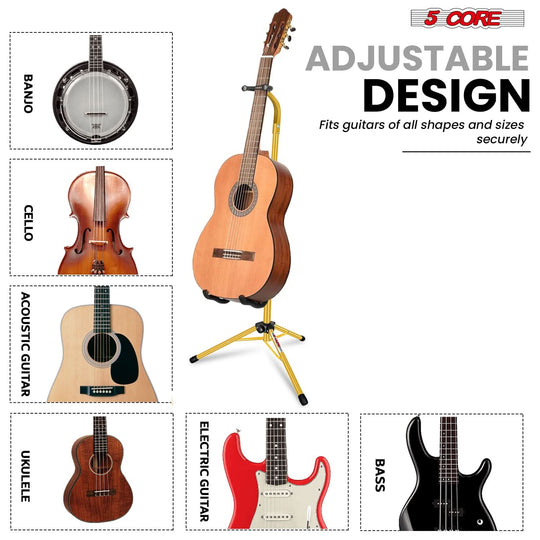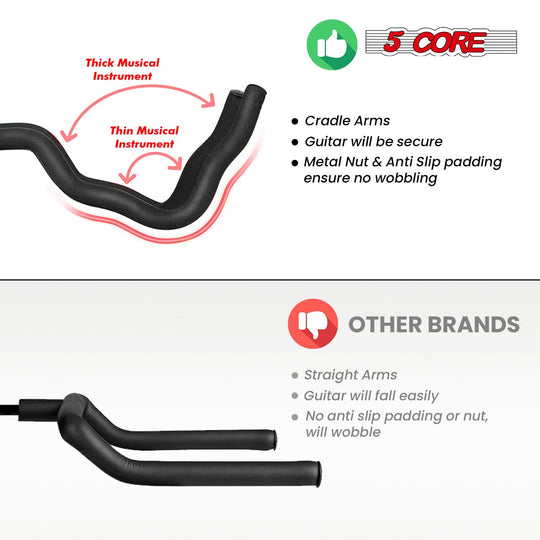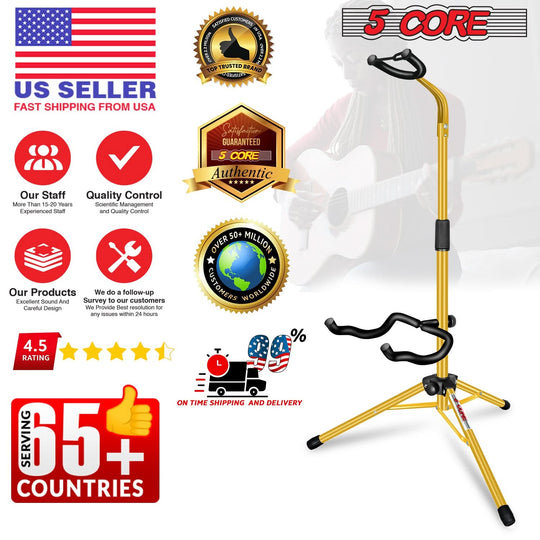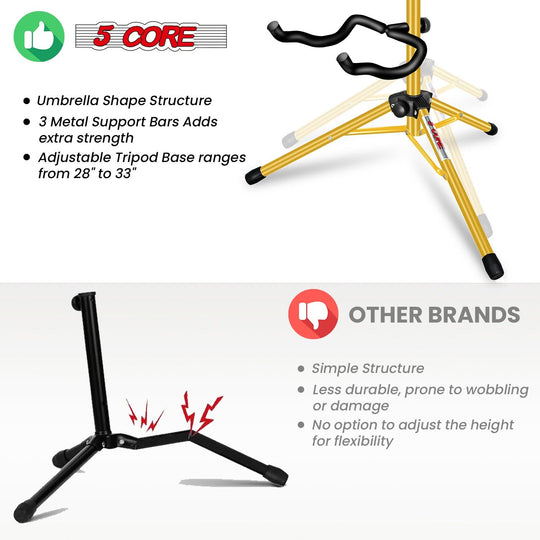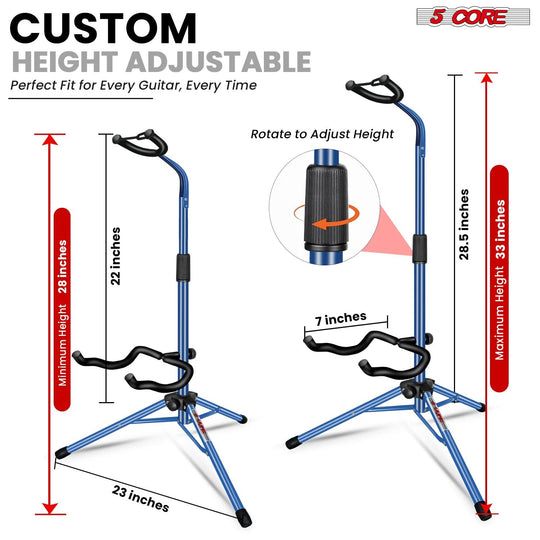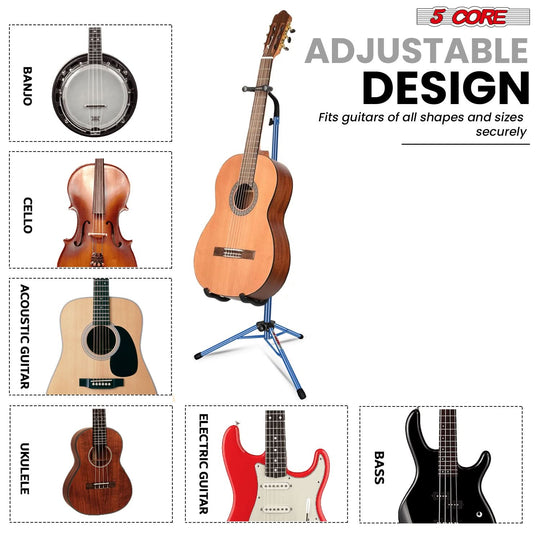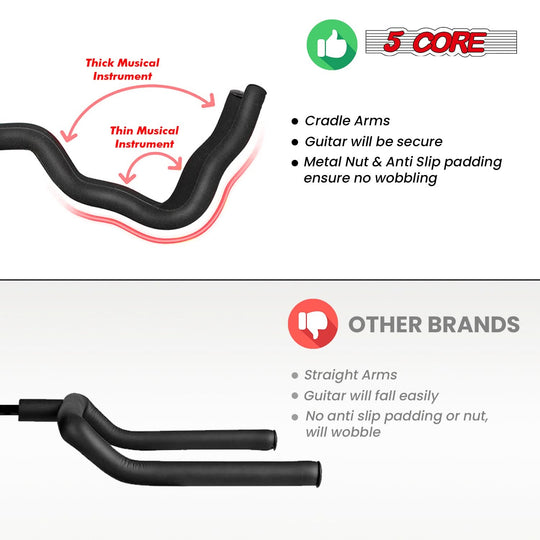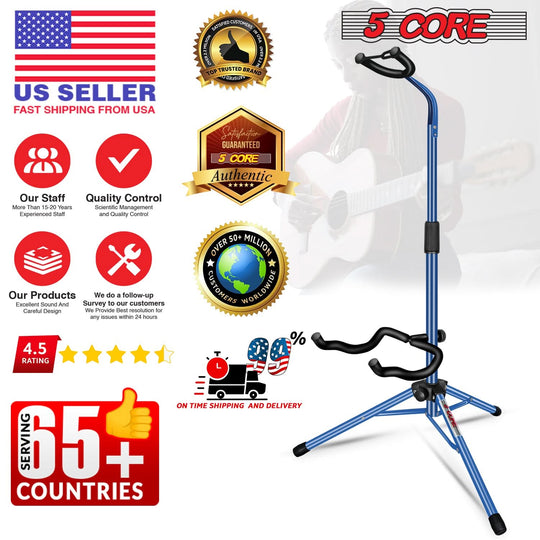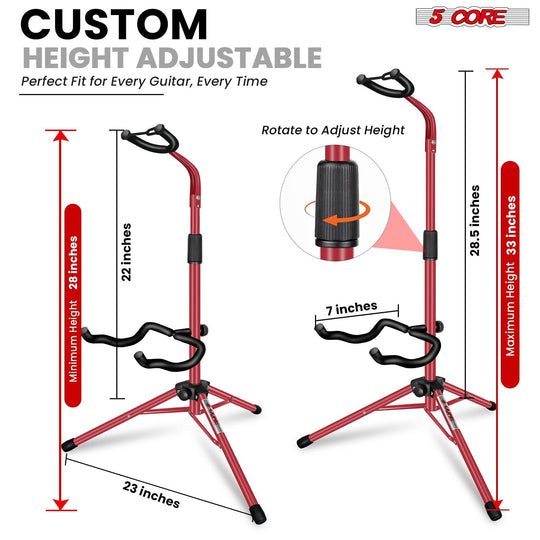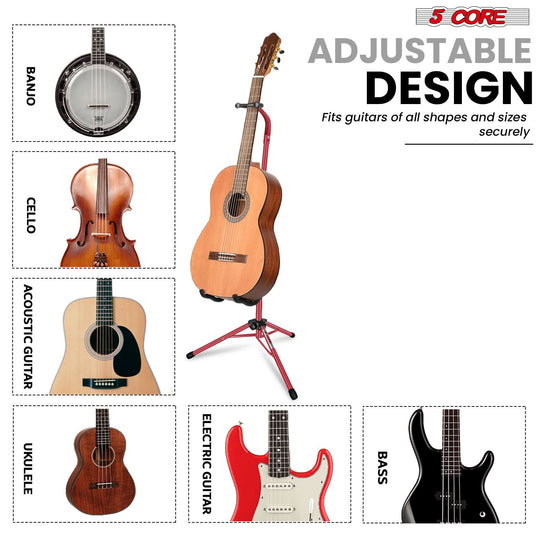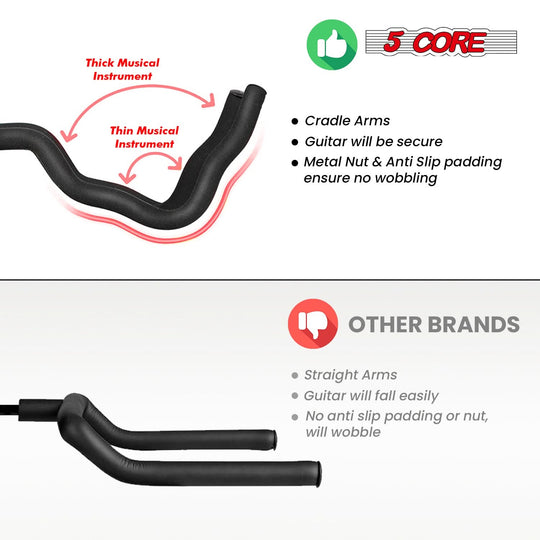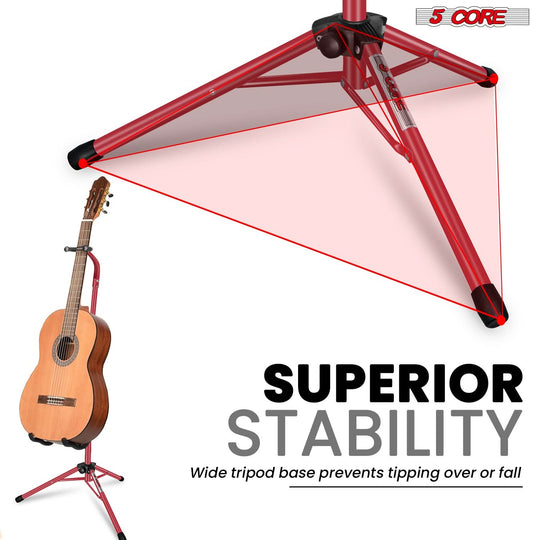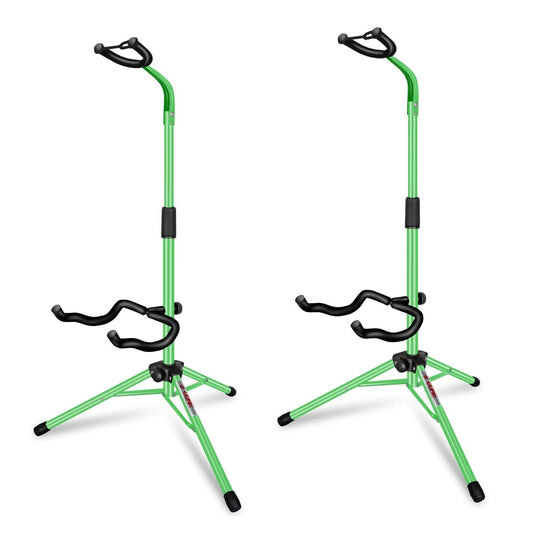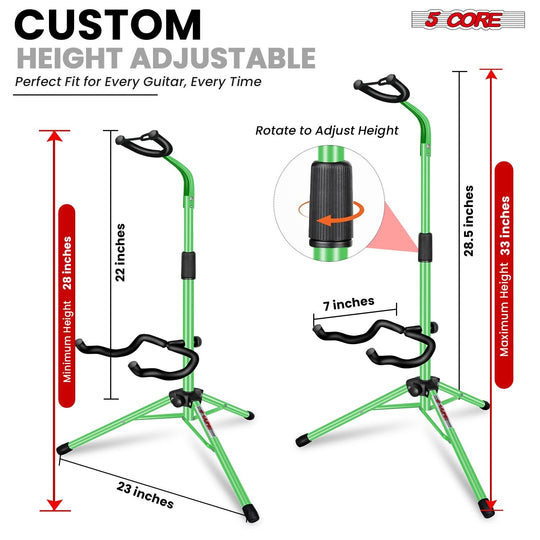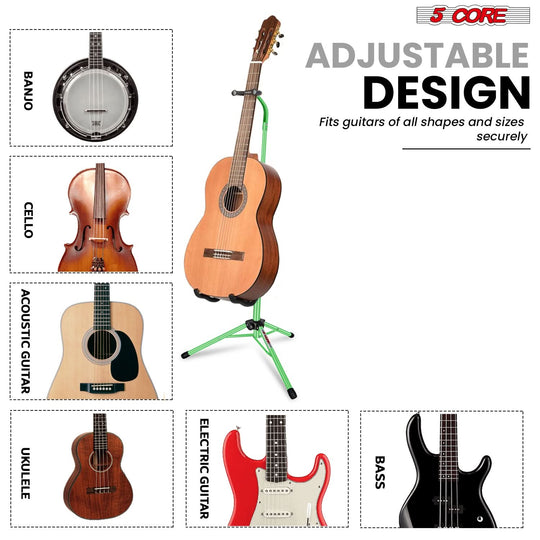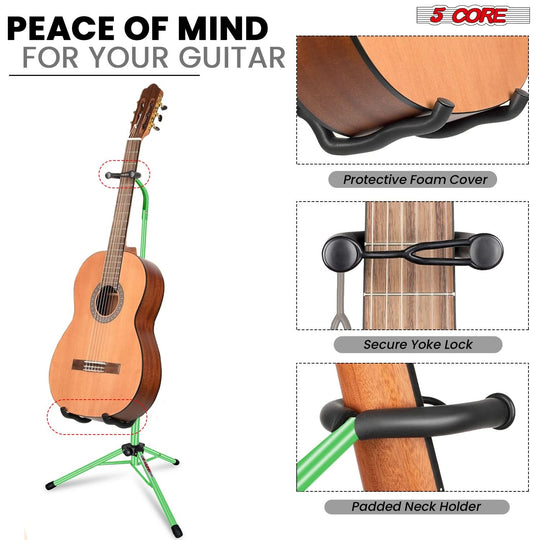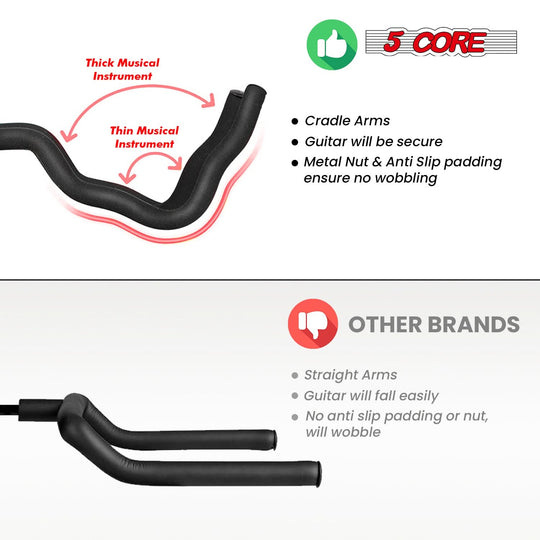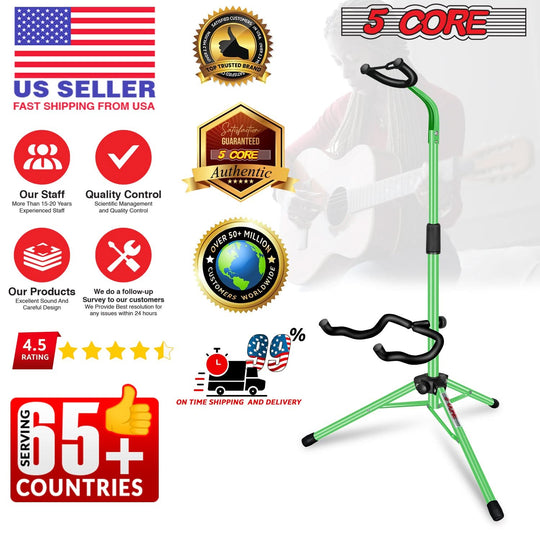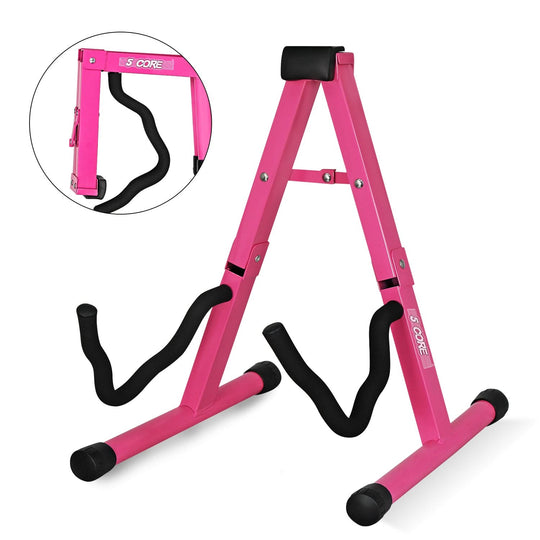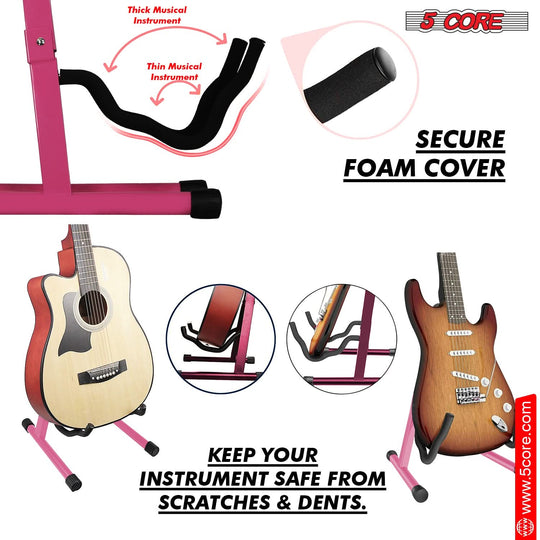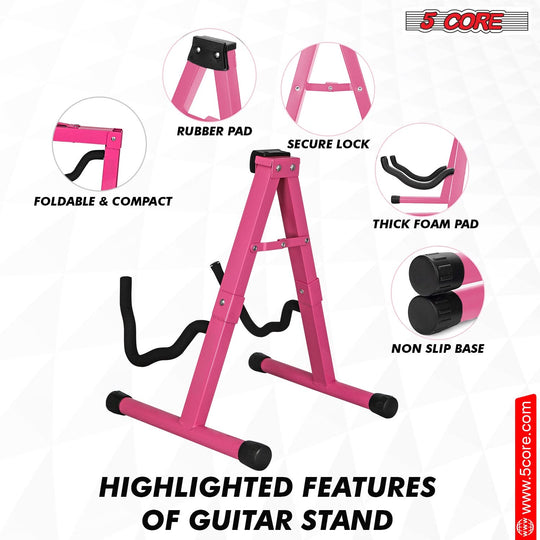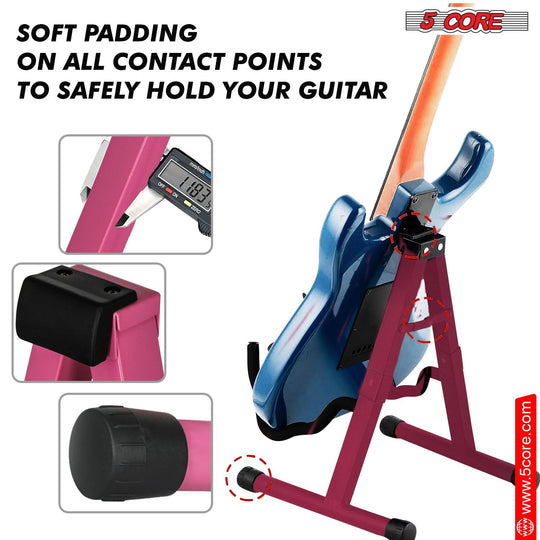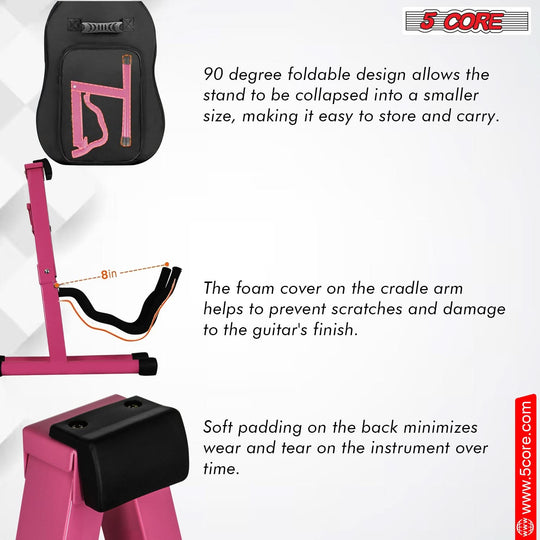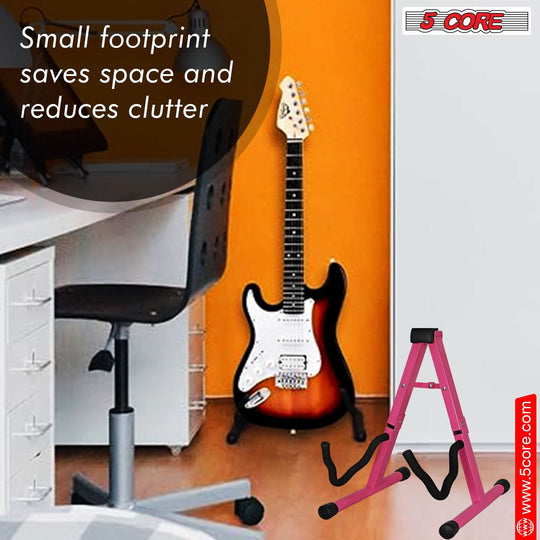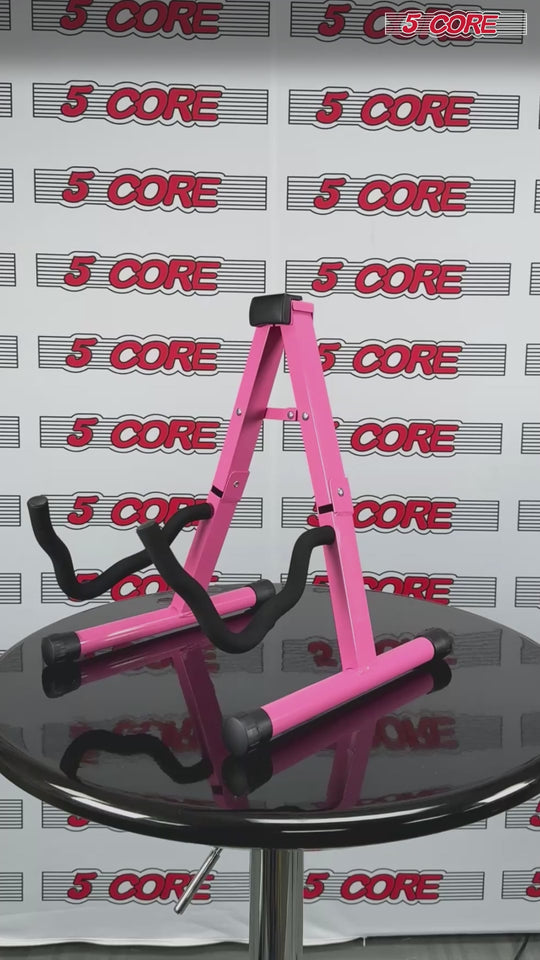Filter and sort

Choosing the right guitar stand is more than just finding somewhere to lean your instrument. A good stand keeps your guitar safe, accessible, and ready to play — and it can also help preserve the finish and structural integrity of your instrument over time. Whether you’re playing acoustic, electric, or ukulele, one wisely chosen stand can make a big difference in your daily routine and long-term care.
Types of Guitar Stands
-
A-Frame Stands: Simple and sturdy, these are suitable for most acoustic and electric guitars. They typically feature adjustable width and rubber feet to prevent slipping and floor scratches. They fold flat, making them portable and easy to store. However, they offer limited neck support.
-
Tripod Stands: The most common type, these have three legs and support the guitar's neck and body. They usually offer height adjustment and padding to protect the instrument. While widely used, some find them less stable unless you choose a well-made model like the Hercules GS414B Plus that offers auto-grip features for better security.
-
Wall Hangers: Wall-mounted stands keep guitars off the floor, saving space and reducing accidental knocks. High-quality models have padded supports to avoid damage to the guitar’s finish. These are excellent for long-term storage and display, especially for safe keeping in limited spaces.
-
Multi-Guitar Racks: Designed to hold several guitars simultaneously, these racks are ideal for studios or home collections, providing secure, space-efficient storage. They often use neoprene rubber cushioning to protect instrument finishes and can hold from 3 up to 7 guitars.
-
Heavy-Duty Acoustic Stands: Made with robust materials like Swiss steel and featuring molded cork and rubber supports, these stands accommodate various acoustic guitar sizes securely, with enhanced durability for heavy instruments and frequent use.
Ultimate Buyer’s Guide
Types of Guitar Stands
-
Floor Stands (Tripod and Rack-Style): The most common guitar stands are floor stands, which come mainly in tripod (three-legged) or rack-style designs. Tripod stands provide neck and body support with adjustable height and padded contact points, suitable for both acoustic and electric guitars. Rack-style stands hold multiple guitars simultaneously, ideal for studios or musicians with collections.
-
Rack / Multi-Guitar Stands: Designed to hold 2 or more guitars, these stands maximize space efficiency and offer organized, secure storage for multiple instruments. They are constructed from sturdy, often steel materials with neoprene rubber or foam padding to protect guitar finishes. Some models can hold up to 7 guitars safely, functioning well in studios or home setups.
-
Wall Hangers: Wall-mounted stands save floor space and create an attractive display. They must be securely mounted on studs or solid walls using proper hardware to ensure safety. Good wall hangers use padded contact points made of soft, non-reactive materials to protect delicate finishes like nitrocellulose lacquer.
-
Specialty Stands: For guitars with unusual shapes (Flying V, double-neck, extended basses) or enhanced security needs, specialty stands are designed with features such as spring-loaded yokes or flip-lock neck holders. These provide extra neck security and tailored support for unique instruments.
Key Features to Consider
-
Stability: A wide base or tripod leg configuration ensures the stand does not tip over easily. Rubber feet enhance grip and floor protection.
-
Padding / Contact Points: Soft materials like foam or rubber safeguard the guitar’s finish. Materials must be chosen carefully, as certain foams may react poorly with some finishes (especially nitrocellulose).
-
Capacity: Multi-guitar racks suit players with multiple instruments by offering efficient storage without clutter.
-
Portability: Foldable and lightweight options suit gigging musicians or those with limited space. Quick assembly and disassembly are beneficial for transport and setup.
-
Height / Neck Adjustability: Adjustable stands accommodate different guitar sizes—from ukuleles to bass guitars—ensuring proper fit and support.
Maintaining your guitar stand properly ensures the stand's longevity and keeps your instruments safe and secure. Here is a comprehensive guide on mistakes to avoid during setup and essential maintenance tips for guitar stands, drawing on detailed product instructions and best practices:
Mistakes to Avoid During Setup
-
Uneven Surface Placement: Always place your guitar stand on a flat, stable surface. Uneven floors can cause the stand to wobble or tip, risking damage to your instruments. If the stand has adjustable feet or levelers—like the MAHANCRIS GSHB6501 Multi-Instrument Guitar Stand—use them to stabilize the stand effectively.
Overloading the Standpan><span>
Do not exceed the recommended capacity of your guitar stand or multi-guitar rack. For example, the MAHANCRIS GSHB6501 is rated for 5-7 guitars with a load capacity of 10-20 kg. Overloading stresses the frame and padding, increases tipping risk, and may damage both the stand and guitars.</p> -
Avoid stands with padding materials that react poorly with sensitive finishes, especially nitrocellulose lacquer. EVA foam padding, like that in quality stands, protects instruments but should be periodically inspected for wear or damage to prevent scratches. -
Incorrect Positioning of Instruments
Place guitars so their weight is properly balanced within the padded slots or hangers. Avoid letting instruments rest at risky angles that might cause slipping or tipping. -
Ignoring Safety Features
Engage any available locking or spring mechanisms to secure instruments, and confirm the stand’s base is stable before releasing your guitar. Using anti-tip kits to anchor multi-guitar stands is recommended to prevent accidents.
Maintenance Guide
-
Regular Cleaning:
Wipe down the metal and wood surfaces of your guitar stand with a soft, dry cloth regularly to remove dust and prevent grime buildup. For tougher marks, use a slightly damp cloth followed by drying immediately. Avoid abrasive cleaners or solvents which can damage finishes. -
Inspect and Preserve Padding:
Periodically check the EVA or foam padding for cracks, compression, or damage. Replace padding if it is worn to continue protecting your instruments properly. -
Tighten Hardware:
Check and tighten screws, bolts, and joints occasionally to maintain stand rigidity. Foldable or adjustable stands especially require regular approval of hardware tightness for safety and smooth operation. -
Keep Dry and Avoid Moisture:
Store your stand in a dry, cool environment away from humidity and direct sunlight to avoid metal corrosion and material degradation. -
Use Finish-Safe Coverings:
If you own guitars with sensitive finishes (like nitrocellulose), consider covering contact points on the stand with soft cotton fabric or check that stand padding is compatible with your guitar finish to prevent damage.
By avoiding setup errors such as uneven placement and overloading, and by following maintenance routines like regular cleaning, padding inspection, and hardware tightening, you can extend your guitar stand’s lifespan and ensure secure, stable storage for your instruments.
Guitar Stand FAQ2>
an>Question: Can a guitar stand damage my guitar’s finish?
Answer: Yes, it can — depending on the material of the padding. Some rubber or foam may react with sensitive finishes like nitrocellulose. <span>Gravity® | take the stage Many players wrap stands with soft cloth or silk to mitigate this. > “Many guitar stands are known to damage nitro finishes … I just cut up a t shirt and wrapped my stand …”n> Reddit
Answer: Absolutely. Just ensure the rack is rated for your instrument weights and shapes. Also, watch how tightly the instruments sit — spacing matters.Question: Should I store my guitar on a stand all the time?
Answer: Many musicians find that keeping the guitar on a stand encourages more frequent practice. Reddit However, make sure the stand is stable and doesn’t expose the instrument to harmful conditions (e.g., humidity, direct sunlight).pan></p>Question: How do I choose a stand for a V-shaped or flying-V guitar?
Answer:Look for stands with neck yokes (rather than bottom support) that can safely cradle unconventional headstocks or bodies. Some racks are more adaptable than standard tripod designs.Question: What is the difference between a floor stand and a wall hanger?
Answer: A floor stand sits on the ground and supports the guitar’s weight from the bottom or neck area. A wall hanger mounts directly to the wall and suspends the instrument by the headstock. Floor stands offer mobility, while wall hangers save space and create a cleaner look.Question: Are folding guitar stands reliable for gigging?>
Answer: Yes, folding stands are commonly used by performing musicians. They are designed for portability and quick setup. However, always check the locking mechanisms and joints before placing your guitar to ensure stability on uneven stages.Question: How much space does a multi-guitar stand require?
Answer: It depends on the stand’s capacity. A rack that holds 3–5 guitars typically needs around the width of a small bookshelf, while larger racks for 7–9 instruments require more floor area. Always measure the space in your room or studio before choosing a multi-guitar stand.
Question: Will a guitar stand affect tuning stability?
Answer: A stand itself doesn’t change tuning, but environmental factors matter. If the instrument is stored near air vents, sunlight, or humidity fluctuations, tuning may drift. The stand should be placed in a stable environment for best results.Question: Can I keep a guitar on a stand if I have pets or children?
Answer: Yes, but use a stable tripod or rack with a wide base. For extra safety, choose stands with neck-support locks or place the stand in a low-traffic corner to reduce accidental knocks.
Answer: Padding is usually fine for short-term use. For long-term storage — especially if your guitar has a sensitive finish — placing a cotton cloth barrier between the guitar and padding can prevent chemical reactions, color transfer, or pressure marks.Question: Do different types of guitars need different stands?n>
Answer: Many stands are universal, but certain instruments benefit from specialized designs. Acoustic guitars need wider cradles, electrics pair well with neck-yoke stands, and ukuleles require adjustable height stands because of their smaller size.>Question: What is the ideal placement for a guitar stand in a room?
Answer: Place the stand away from direct sunlight, heaters, air conditioners, or humidifiers. A shaded corner with stable flooring helps maintain the guitar’s temperature and humidity levels.<p dir="ltr">Question: Can a guitar fall off a stand easily?
Answer: It depends on the stability of the stand and placement of the guitar. Properly designed stands with non-slip feet and correctly positioned padding dramatically reduce the risk. Always make sure the instrument is centered and balanced.Question: Is a multi-guitar stand suitable for travel?
an>pan>Answer:r="" racks="" are="" designed="" for="" stationary="" use="" in="" studios,="" rehearsal="" rooms,="" or="" home="" collections.="" some="" foldable="" models="" can="" travel,="" but="" they="" generally="" bulkier="" than="" single="" guitar="" stands.<="" spa<="" p="">Choosing the right guitar stand is ultimately about protecting your instrument, keeping it accessible, and creating a setup that supports consistent practice. Whether you use a simple floor stand, a compact ukulele holder, or a multi-guitar rack for a growing collection, the goal is the same—safe, stable storage that fits your space and your playing habits. By understanding compatibility, avoiding common setup mistakes, and maintaining the stand over time, you ensure your instrument stays in great condition and always ready to play. A well-selected stand doesn’t just hold a guitar; it supports your entire musical workflow.
Author Bio - Alex Even
Hi, I’m Alex Even. I’ve been working in the pro audio industry for over 15 years, specializing in everything from studio recording setups to live sound systems. Whether it’s fine-tuning a PA DJ system, choosing the right microphone, drum stool, keyboard bench or setting up a home studio, karaoke setup, I’ve spent years helping musicians, audio engineers, and content creators get the sound they’re looking for. I’m passionate about making audio technology easy to understand and even easier to use—because great sound should be accessible to everyone.
-


